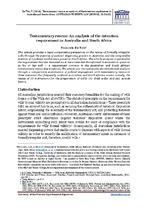| dc.contributor.author | du Toit, Francois | |
| dc.date.accessioned | 2014-12-11T13:28:58Z | |
| dc.date.available | 2014-12-11T13:28:58Z | |
| dc.date.issued | 2014 | |
| dc.identifier.citation | Du Toit, F. (2014). Testamentary rescue: an analysis of the intention requirement in Australia and South Africa. Australian Property Law Journal 23: 56-82 | en_US |
| dc.identifier.issn | 1038-5959 | |
| dc.identifier.uri | http://hdl.handle.net/10566/1320 | |
| dc.description.abstract | This article provides a legal-comparative perspective on the rescue of formally irregular wills through the exercise of judicial dispensing powers in Australia and the comparable exercise of a judicial condonation power in South Africa. The article analyses in particular the requirement that the deceased must have intended the informal instrument in question as his or her will — a requirement common to the Australian and South African testamentary rescue dispensations. The article contextualises the
aforementioned analysis through a comparative examination of judicial engagement with testamentary rescue in three scenarios that frequently confront Australian and South African courts, namely, the rescue of (i) instructions for the preparation of wills; (ii) draft wills; and (iii) suicide letters. | en_US |
| dc.description.sponsorship | National Research Foundation (NRF) | en_US |
| dc.language.iso | en | en_US |
| dc.publisher | LexisNexis Australia | en_US |
| dc.rights | This is an author final version of an article published by Lexis Nexis Australia. Copyright UWC. This work is licensed under a Creative Commons Attribution-Non-Commercial 4.0 International License. | |
| dc.subject | Testamentary rescue | en_US |
| dc.subject | South Africa | |
| dc.subject | Australia | |
| dc.title | Testamentary rescue: an analysis of the intention requirement in Australia and South Africa | en_US |
| dc.type | Article | en_US |
| dc.privacy.showsubmitter | false | |
| dc.status.ispeerreviewed | true | |

